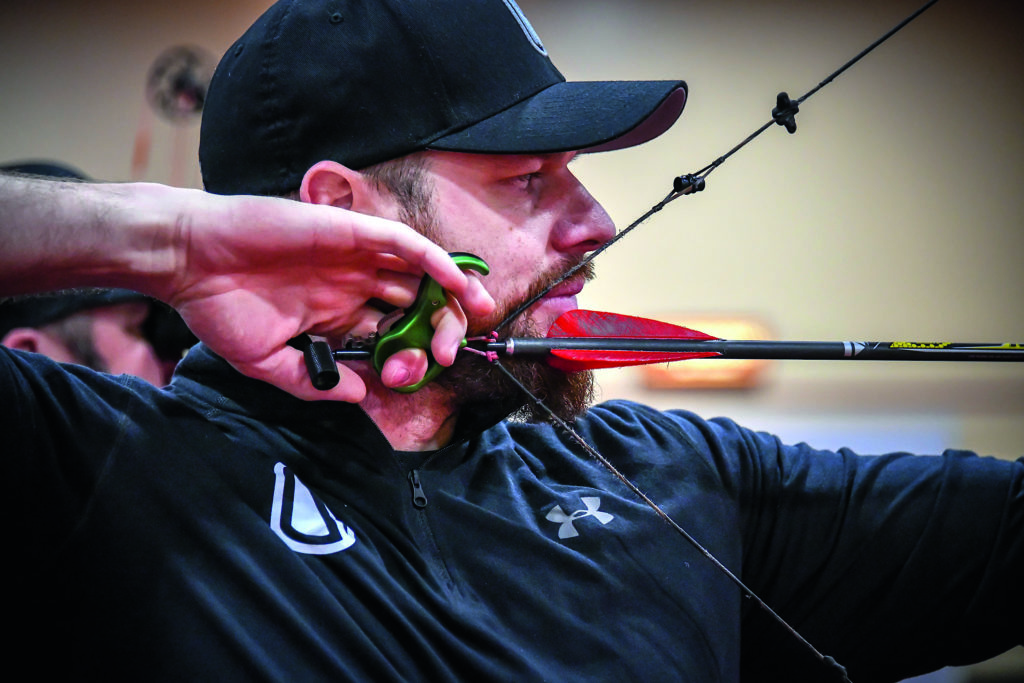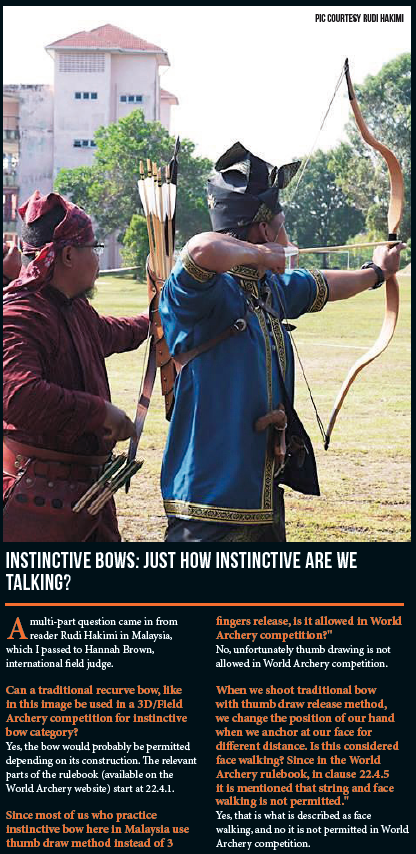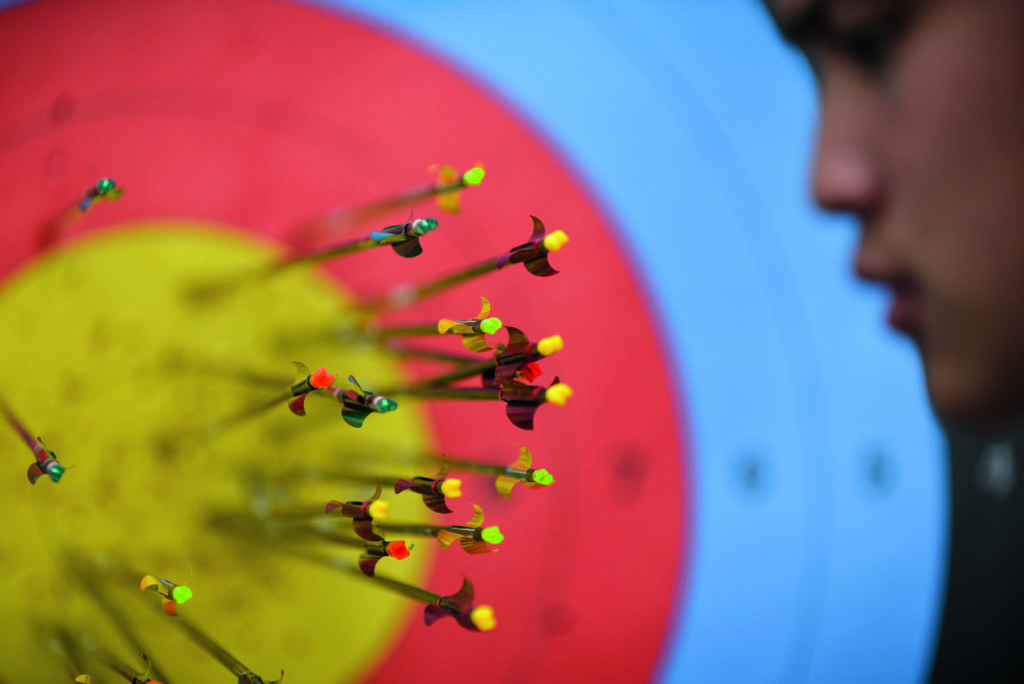It’s that time again for our experts to answer your questions, so if you have any then please send them to [email protected]
Q: I usually shoot with a back tension release but it’s difficult to use in bad weather, would you recommend switching to a trigger release under any conditions?
Duncan Busby says: Using a back tension release aid correctly will allow you to recruit your back muscles to execute a well balanced and controlled shot with repeatable form.
As a result I am a huge advocate of back tension releases, after years of struggling with form and aiming problems. Personally, I’ve found that the hinge-style release has provided enormous benefits to my shooting.
Ideally you should stick to one style of release whatever the weather conditions as this will help maintain your shooting form and prevent bad habits from developing.
However, there are some instances where shooting a back tension could be detrimental to your score. Gusty, unpredictable wind is particularly hard to shoot in, whatever style of release aid you use but some archers find a trigger release can give them a little more control over their shot timing.
Shot timing is especially important in adverse weather conditions; you may have only a few seconds to release your arrow before your sight is blown off centre, so executing the shot quickly becomes far more advantageous than maintaining perfect form.

Executing a shot using a back tension release correctly is usually a longer process than that of a trigger; slowly increasing the pressure on the cam wall using your back muscles can take several precious seconds. And if your sight moves during this time you’ll either have to choose to reduce the pressure in your shot and start the process again or risk releasing the arrow wherever it’s aimed.
In a tournament with time constraints constantly re-starting the release process can be tiring and stressful and it can also lead to a breakdown in your shot execution.
Using a trigger which allows you to stop the arrow from releasing simply by removing your thumb or finger from the peg, without altering the pressure in your shot, simplifies your shot sequence. It makes resetting your release process much quicker, and as you have more control over your shot it can be less damaging to your form in the short term.
Field archers may also benefit from occasionally switching to a trigger release; the steep angles of some targets can make it almost impossible to shoot using back tension.
As they must sometimes move their bodies out of alignment to aim high or low, field archers occasionally rely on an unconventional release process in order to execute the shot.
I know many archers who carry a trigger release with them despite being a back tension shooter; if you feel this would be of benefit to you, just ensure you choose a trigger of a similar design and set it correctly, so you are able to shoot with the same technique as you would with your back tension.
Switching between releases should not cause any problems so long as you maintain your form and you keep both of your release aids in good working condition.

Q: Will I ever get any good at archery?

Roy Rose says: Being a successful recurve and compound shooter, and having written about archery for almost half a century, been a coaching seminar presenter for decades, and finally, and perhaps most importantly, a keen observer of the elite all my adult existence, my most frequently asked question is just: ‘what are the secrets to accurate shooting?’
Of course, secrets is a misnomer, there are no secrets, but there are essentials, which all great exponents religiously incorporate in their preparation, form and execution.
I believe that anyone who follows these principles will become a very successful archer, irrespective of natural talent, eye hand co-ordination, or any other pre-requisite. Ours is such a short duration, simple set of actions, that specific body types, and the other demands most sports require, are not essential. So, what is essential?
The primary essential is equipment preparation and knowledge. I am constantly dismayed in seminar situations to find that a considerable minority have no real concept of how to set up and tune recurve or compound bows.
They marvel at the accuracy of the elite, but are attempting to reproduce that level without the vital first step, a set up and tuned bow, and properly matched arrows. Assuming our bow and shafts are now working with us, and not against us, let’s move to the nitty gritty of accurate archery.
Logically an archer needs to have a cross section of things in place to obtain repetitive performance, but four broad essentials – call them secrets if you want – cover all the bases, and I reiterate them repeatedly in my advice.
Essential One is comfortable form. The whole essence of our sport is duplication, and the best archery truism is undoubtedly that “comfortable is repeatable” and exact “repeatable” is what we are all about. Notice I said comfortable form, not necessarily accepted perfect form.
This is where personal idiosyncrasies come into play, where even the finest champions have little form characteristics which may vary from the accepted, but which create a comfort level from which they can operate with video replay like precision.
Essential Two is to resist the desire to assess, judge and change. Change is often a life requisite, and many times that change is for the best, but in archery, change is your enemy. It’s logical! If you wish to obtain duplicative set up form and execution, it cannot happen if you are in a state of constant flux.
I have personally seen many potentially top line shooters lose their way, because of a continuous pattern of assessment, judgement and subsequent change. You will never achieve duplication, which is our whole aspiration, if you constantly institute change as a solution.
Watch the really great recurvers and compounders who have been on the international line, sometimes for well over a decade. What you see in form and execution in 2019, is usually exactly what you saw in 2009.
Count up the hours of practice and competition over that period of doing this 20 second or so routine over and over without variation, and why they are supremely accurate is no longer a mystery. Set Essential One in place, and make certain Essential Two follows, and you are well and truly on accuracy avenue.
Essential Three centres on shot execution. Champion shooters will tell you repeatedly that if an archer has quality execution then it is the primary attribute in becoming elite.
I constantly see competitors with highly suspect form, which should be bringing them undone, mounting the podium, because they have superb shot execution. Essential Three therefore very much ties in with Essential Two for the compound archer, with execution centering entirely around the choice and use of a release aid.
The old enemy – change – once again rears its ugly head. Chopping and changing release aids, and how you execute with them, is patently contradictory to the goal of duplication. The vast majority of the elite have a long term, sometimes a lifetime association with one release, and one method of making it fire.
Finally we have Essential Four. Our first three essentials must be supported by practice and competition familiarity, or our quest for our ultimate potential will fall short.
This duplicative function we are seeking goes hand in hand with serious practice. Practice is by definition repetitive; supreme achievers in all sports are religious practicers. Familiarity breeds confidence. Even the elite contend with nerves, but having trodden the path many times before, their trust meter is high.
In some aspects, these essentials are broad, and in other ways they are very specific, but if you work within these parameters, you will certainly end up being the best you can be.
For the best field sports news, reviews, industry and feature content, don’t forget to visit our sister publications Sporting Rifle, Clay Shooting Magazine, Airgun Shooter, and Gun Trade News. And our YouTube shows The Shooting Show and The Airgun Shooter. For subscriptions, please visit https://www.myfavouritemagazines.co.uk/

